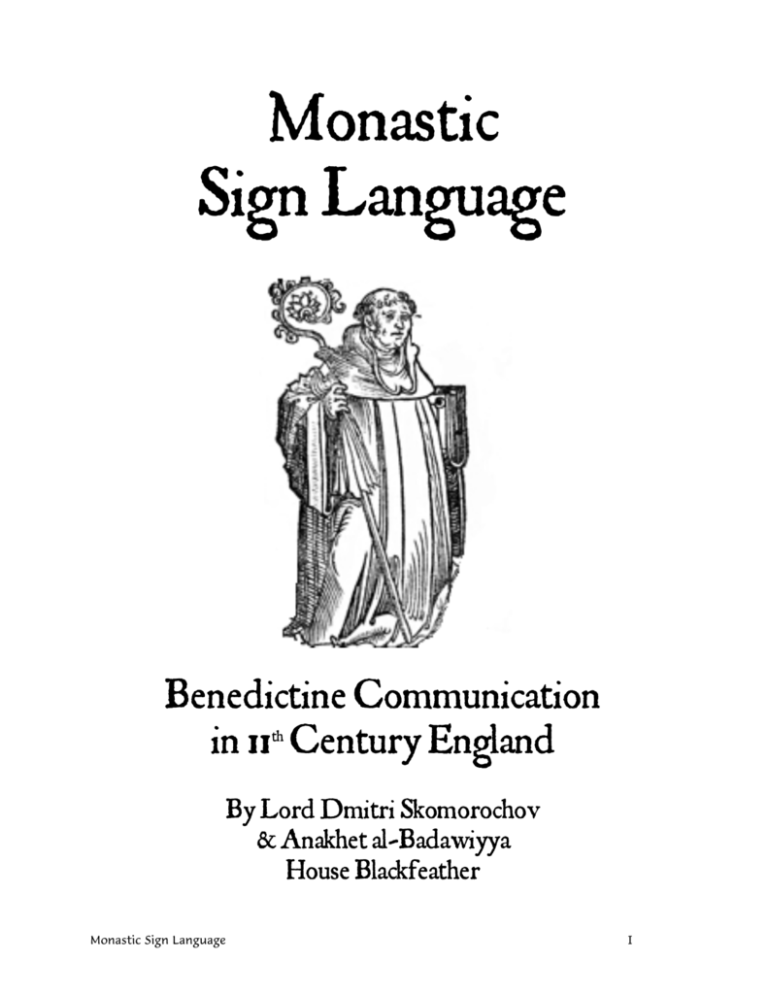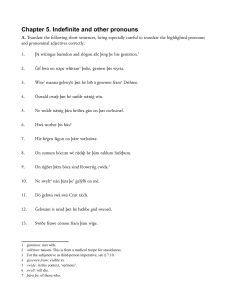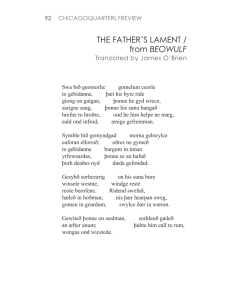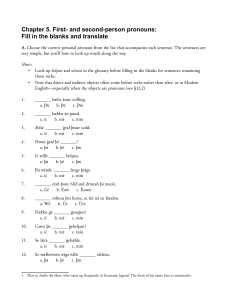Monastic Sign Language
advertisement

Monastic Sign Language Benedictine Communication in 11 Century England th By Lord Dmitri Skomorochov & Anakhet al-Badawiyya House Blackfeather Monastic Sign Language I Canterbury Cathedral, England The Year: 1050 For your enlightenment, these two Benedictine monks, Brother Damon and Brother Andrew, will demonstrate samples of the hand signals that their monastery uses to preserve the vow of silence while still allowing the monks to convey their needs to one another. Due to their restrictive vow of silence, they are unable to speak, but through hand signs and gestures, they hope that everyone will be able to understand their communication. At the end of the demonstration, Archbishop Edsige has granted permission for the monks to speak - allowable under circumstances such as communicating with outsiders - if there are any questions or comments. Monastic Sign Language II Table of Contents Cover Page Introduction I II Table of Contents III Monastic Sign Language Samples – Old English IV Monastic Sign Language Samples – Modern English Benedictine Rule V VI Monasteriales Indicia VII The Sign Language VIII Bibliographie IX Reference Photocopies Monastic Sign Language III Monastic Sign Language Samples Old English • Ærest þæs abbades tacen is þæt mon his twegen fingras to his heafde asette and his feax mid genime. • Ðæs diacanes tacen is þæt mon mid hangiendre hande do swilce he gehwæde bellan cnyllan wille. • Gyf mon hwæt be þam profoste tæcan wille, þonne rær þu þinne scytefinger ofer þin heofod forþi þæt is his tacen. • Gyf þu oflætan habban wille, þonne byg þu þinne scytefynger to þinum þuman. • Ðonne þu storfæt habban wile, þonne wend þu þine hand ofdune and wege hi swilce þu styre. • Gyf þu candelsticcan habban wille, þonne blaw þu on þinne scytefingre and hald þine hand samlocene, swylce þu candelstæf hæbbe. • Gyf þe smælre candelle geneodige, þonne blaw þu on þinum scytefingre. • Gyf þu biblioƒecan habban wille, þonne wege þu þine hand and rær up þinne þuman and sete þine hand bradlinga to þinum leore. • Gyf þu inne cyricean sittan wille for hwylcere untrumnysse, þonne wende he his hand adune and ahnigenum heafede him leafe biddan and his hand on breost asette. • Gyf þu wille þæt hwa sittendra manna up arise, þonne wend þu þine hand and hi be dæle up abræd. • Ðonne þu swype habban wille, þonne wege þu þine fyst swa swa we beforan cwædon and rær up þine twæg fingras. • Gyf þe syxes genyoƒige þonne sniƒ þu mid þinum fingre ofer þonne oþerne, swylce þu cyrfan wille. • Briwes tacan is þæt þu wege þine fyst, swilce þu briw hrere. • Ðonne þu cyse habban wille, sete þonne ine twa handa togædere bradlinga, swilce þu wringan wille. • Gyf þe meolce lyste, þonne strocca þu þinne wynstra finger mid þinre swyþran hande þam gelice swylce þu melce. • Huniges tacen is þæt þu sette þinne finger on þine tungan. • Ðonne þu fisc habban wylle, þonne wege þu þyne hand þam gemete þe he deþ his tægl þonne he swymƒ. • Ðonne þu drincan wylle, þonne lege þu þinne scetefinger andlang þines muþes. • Beores tacen is þæt þu gnide þine hand on þa oþre. • Nægelsexes tacen is þæt þu mid þinum scitefingre do ofer þinne oþerne, swilce þu ceorfan wille, and straca syþþan on þin leor mid þinum fingre, swilce þu scearan wille. • Pylecan tacen his þæt þu strece forƒ þin wenstre handstoc and plyce innan mid þinre wynstran hande. • Ðæs cyninges tacen is þæt þu wende þine hand adune and befoh þin heofod ufeweard eallum fingrum on cynehelmes tacne. • Lædes mannes tacen is þæt þu ƒe mid ealre hande be þinum cynne nyme swilce þu þe be bearde niman wille. • Gehwylces ungehadodes wifes tacen is þæt þu mid foreweardum fingrum þin forewearde heafod fram þam anum earan to þon oþrum on bindan tacne. Monastic Sign Language IV Monastic Sign Language Samples Modern English • First, the abbot's sign is to set two fingers on your head and at the same time grab your hair. • The deacon's sign is that one should make a motion with one hand hanging, as if to ring a small bell. • To indicate the prior, raise your forefinger over your head, for that is his sign. • If you would have a sacramental wafer, bend your forefinger to your thumb. • When you would have a censer, move your hand downwards and move it back and forth, as if swinging. • If you would have a candlestick, blow on your forefinger and hold your hands locked together as if you had a candlestaff. • If you need a small candle, blow on your forefinger. • If you would have a Bible, move your hand back and forth, raise up your thumb and set your hand flat against your cheek. • If you wish a sitting man to rise, turn your hand and move it up quickly in stages. • If you wish him to sit, then turn it downward and move it down in stages. • When you would have a whip, move your fist back and forth as we described before, and raise up your two fingers. • If you need a knife, cut with one finger over the other as if carving. • The sign of porridge is to move your fist back and forth as if stirring porridge. • When you would like cheese, set your two hands flat together, as if pressing. • If you would like milk, stroke your left finger with your right hand as if you were milking. • The sign of honey is to set your finger on your tongue. • When you would like fish, move your hand back and forth the way a fish moves its tail, when it swims. • When you wish to drink, lay your forefinger along your mouth. • The sign for beer is to knead one hand on the other. • The sign of the razor is to put one forefinger over the other, as if carving and then to stroke your cheek with your finger as if shaving. • The sign for a fur garment is to stretch forth your left sleeve and pluck the inside with your left hand. • The sign of the king is to move your hand down, then seize your head on top with all your fingers in the shape of a crown. • The sign of a layman is to take yourself with both hands by the chin as if taking yourself by the beard. • The sign of a laywoman is to move your fingers across your forehead from one ear to the other in the sign of a headband. Monastic Sign Language V Benedictine Rule During the Middle Ages in Europe, no organization existing had as much power as the Church, and the monasteries were a very important part of that organization, maintaining and promoting the spirituality that was the basis for their religion. The monks at the various monasteries had different duties and focuses from monastery to monastery, but they all had a strict set of rules that they were supposed to live by. In the 6 century, Saint Benedict put together his Holy Rule, a set of instruction that all th Benedictine monks – and most other denominations – followed as law. This Holy Rule explained, in great detail, every aspect of a monk’s life, from the times of day that prayers were said, to the manner of men who should wear the robes, mealtime observances, and the behavior of any monk who wished to serve God in a monastery. One of the most well-known rules of the monastic orders was the vow of silence, where a monk was supposed to remain completely silent in order to “…refrain from evil words…” and refrain from “…all vain talk, gossip, and laughter…” (Stork, pg. 3). According to the translation of the Holy Rule, Benedict felt that any speech should be kept to an absolute minimum – “…if at times we ought to refrain from useful speech for the sake of silence, how much more ought we to abstain from evil words…” (Verheyen, pg. 11) – and only permitted under certain circumstances – “…unless the needs of guests should arrive, or the Abbot should perhaps give a command to anyone…” (Verheyen, pg. 28). And therefore not having permission or cause to speak normally with each other, but still needing to communicate basic ideas, an alternate method of communication had to be found. Monastic Sign Language VI Monasteriales Indicia There were only a handful of Old English manuscripts that dealt with the various methods of non-verbal communication used in medieval monasteries. These were dated to the late 12 century, th two from the monastery at Cluny (1075 & 1083), one from the monastery at Fleury, dated at approximately 1087, and the earliest one being found at Christ Church at Canterbury in England (Banham, pgs. 9 & 14). The focus of this project is the manuscript known as Cotton Tiberius A.III, the Monasteriales Indicia that was found at Christ Church, presumed to be dated from the mid 11 th century, slightly before the other examples. The section of the manuscript devoted to the Monasteriales Indicia was located inside of set of Benedictine Rule called the Regularis Concordia, a set of St. Benedict’s Holy Rule that was a full set of instruction for monkish behavior (Banham, pg. 14 & Stork, pg. 5). Of the 173 folios concerning every aspect of monastic life, the folio pages from 97 recto to 101 verso devoted themselves to the main hand gestures that would replace the spoken word while a monk was following his vow of silence. Within this manuscript, the Canterbury monks are shown using a recorded 127 signs, though this is far from the complete list, and is in fact very dissimilar to the lists of signs found at Cluny and Fleury (Stork, pgs. 5-6). The Monasteriales Indicia list deals primarily with signs representing the methods and materials of worship (such as the Bible, censer, wafers, etc.), the important people they would deal with (abbot, deacon, king, and anyone else), food and mealtime preparation (signs for fish, cheese, wine, beer, bread, etc.), and signs for most items that they would use on a daily basis. Monastic Sign Language VII The Sign Language Most of the signs used in the Benedictine monasteries are meant to be symbolic of the object or action that is being represented. Stork calls this ‘mimetic’ action, where each gesture shows something would bring to mind an image of what the signer wants, for example ringing a small bell indicates a deacon (no. 2), because he’s the person known for ringing the small bell during ceremonies (Stork, pg. 7). This is also recognized in one of the most well-known signals, waving the hand like a fishtail to indicate fish (no. 70). Even to someone who hasn’t studied the sign language, the sign for fish is easily identified. Different other types of signals are used to identify certain types of changes to the known gestures. For example, the small finger and thumb used in conjunction with another sign indicate large or small, since “…the thumb is the largest finger, the little finger is the smallest…” (Stork, pg. 7). An example of this being used in practice is the sign for the bible (no. 29)– the physical book, not the overlaying concept – which is shown by turning imaginary pages of a book, then showing the thumb to indicate the BIG book, followed by a sleeping gesture to indicate the night office (where the large book was primarily used) (Banham, pgs. 56-7). Also notable examples of gestures being joined together are the sign for knife (no. 55) and the sign for a shaving razor (no. 99). The sign for knife shows a mimetic signal for carving – pretending to carve up your hand – while the sign for a razor shows the same knife sign, but then indicating your own face, to represent putting a knife on your cheek, with the intention of cutting hair. Using this pattern, you could use the knife sign to indicate cutting anything, from a piece of cheese to your hair. For this project, we have selected a wide sampling of various signs used by the monks, choosing signs representing several different aspects of monastic life, and we’ll be ‘testing’ ourselves, with the selected judges grading our accuracy as we sign to each other. Monastic Sign Language VIII Bibliography 1) Author Unknown “Cotton Tiberius A.III” Christ Church, Canterbury, England © Mid Eleventh Century 2) Verheyen, Reverend Boniface “The Holy Rule of St. Benedict” St. Benedict’s Abbey, Atchinson, Kansas © 1949 3) Banham, Debby “The Anglo-Saxon Monastic Sign Language – Monasteriales Indicia” Anglo Saxon Books, Norfolk, England © 1991, 1993, 1996, 2003 4) Stork, Nancy P. “Monasteriales Indicia” San Jose State University, San Jose, California © 2003 5) Butler, Lionel & Given-Wilson, Chris “Medieval Monasteries of Great Britain” Michael Joseph Limited, London, England © 1979 Monastic Sign Language IX











